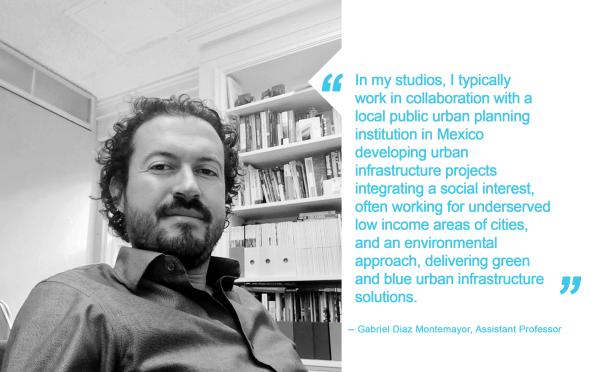Gabriel Diaz Montemayor, Faculty

In this post, we speak with Gabriel Diaz Montemayor. His research explores public space as a social and environmental integrator in the context of arid North America and the hybrid cultures of the expanded border region between Mexico and the US through the means of multi-purpose landscape infrastructure, mobility, water management, public programs/services, and housing.
What program(s) are you associated with in the School? How long have you been at the university?
I am an assistant professor of Landscape Architecture. This is my third year at UTSOA.
In what ways have you incorporated diversity and equity in your teaching and research?
As a design professor, I teach both studios and lecture/seminar courses. In my studios, I typically work in collaboration with a local public urban planning institution in Mexico developing urban infrastructure projects integrating a social interest, often working for underserved low-income areas of cities, and an environmental approach, delivering green and blue urban infrastructure solutions. The studios produce public spaces in disenfranchised areas of cities that try to challenge and change the status quo of public investment in Mexico with projects which maximize positive impact on the population and the environment. To date, I have explored the capacity of these studios in the Mexican cities of Los Cabos, Chihuahua, Hermosillo, and, currently, Ciudad Miguel Aleman in Tamaulipas.
In my elective teaching, I have delivered two courses that have diversity and equity intrinsically embedded into their spirit and content. One looked at the shared border landscape between the US and Mexico from a multifaceted perspective including history, society, economy, and the environment through the lens of the built realm. The other course investigated Latin American Landscapes studied by focusing on the construction of public spaces in a region, which is diverse and full of inequality. I also frequently teach short courses and workshops in Mexico, proposing design investigations similar to the ones I explore at UTSOA. This summer I will teach a workshop in Quito, Ecuador, as well.
My teaching is integral to my research. Related to the subjects of my design studios in Mexico I have recently been investigating how can these projects get closer to implementation by evaluating these projects against other local urban planning and design initiatives such as non-motorized mobility networks. The idea is that green/blue corridors and mobility should be integrated into one and not approached as two different things if we want these implemented.
What does diversity mean to you?
Diversity is the product of true equal opportunity. In this light, it is critical to recognize that not everyone has the same opportunities. I believe that the university plays a main role in revealing this and studying how to produce more opportunities.
Can you describe the sense of community at the School?
Our school studies and develops the various disciplines shaping the human-built realm. As such, we enjoy its breadth and depth, and with it comes a responsibility, which I believe we all experience in the wide array of human emotions.
What are your aspirations –big or small– for the future?
To diversify my teaching, research, and creative endeavor in Mexico and Latin America. UTSOA and UT Austin are major players, I believe, with respect to this region. I also hope to contribute to achieving a real, and demographically proportional, diversity in our institution and its programs. We are also uniquely positioned in our continent to have this!

